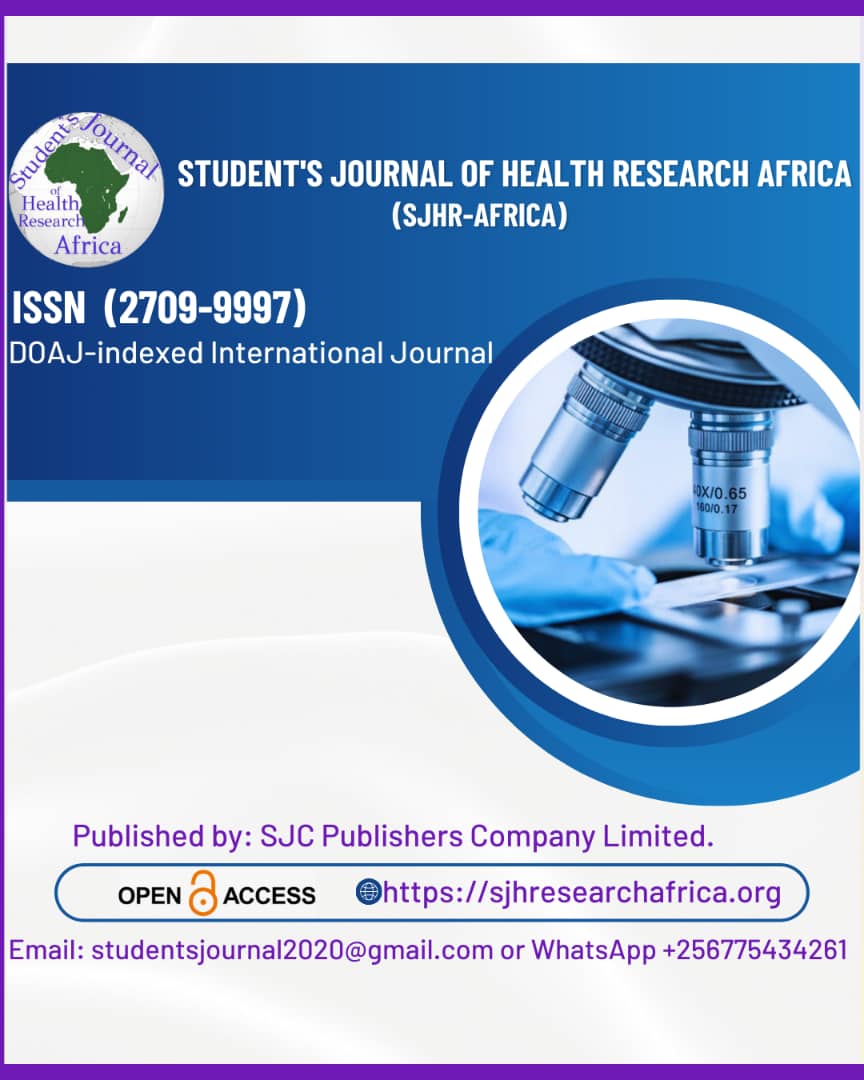Factors Contributing to Puerperal Sepsis among Postnatal Mothers at Entebbe Regional Referral hospital, Wakiso District. A Cross Sectional Study.
DOI:
https://doi.org/10.51168/sjhrafrica.v6i9.1554Keywords:
Puerperal sepsis, Postnatal mothers, Entebbe regional referral hospitalAbstract
Introduction
In Uganda, puerperal sepsis presents a substantial risk to maternal health and deaths due to puerperal sepsis in the national referral hospital account for 12.7 % of the maternal mortality rate annually. The purpose of this study was to determine the factors contributing to puerperal sepsis among postnatal mothers at Entebbe Regional Referral Hospital.
Methodology
The researcher employed a descriptive cross-sectional design, utilizing quantitative methods of data collection from a sample of 30 respondents selected through simple random sampling. The data was analyzed using Microsoft Office programs and presented in the form of tables, graphs, and pie charts.
Results
The results, regarding maternal factors; 19 (63.3%) had received blood transfusion, 16 (53.3%) did not go to the facility with everything needed to use during child birth, 24(80%) had infections such as urinary infections during pregnancy and 14(46.7%) bathed twice in a day. Concerning the health facility factors; 21(70%) were examined more than 4 times by a health work to show progress of labour, 19(63.3%) were not monitored regularly during the whole process of pregnancy, 22(73.3%) did not get adequate health education concerning hygiene needed during pregnancy and 24(80%) mentioned that the available space at the facility is small to accommodate everyone.
Conclusion
In Conclusion, the factors identified were; being transfused with blood, lack of birth preparedness, infections during pregnancy, long duration of labour, and inadequate hygienic practices, multiple vaginal examination, lack of regular monitoring during pregnancy, lack of adequate health education and inadequate space at the hospital.
Recommendations
The health workers should develop comprehensive health education programs for pregnant women and their families, focusing on hygiene practices, early detection of infections, and the importance of prenatal care.
References
Abd El-Maqsoud, E. M., Gaheen, M. A., Belal, G. A. E.-S. R., & Hashem, S. M. (2023). Effect of educational program on nurses′ knowledge and practices regarding prevention of puerperal sepsis. Journal of Pharmaceutical Negative Results, 851–865.
Admas, A., Gelaw, B., BelayTessema, Worku, A., & Melese, A. (2020). Proportion of bacterial isolates, their antimicrobial susceptibility profile and factors associated with puerperal sepsis among post-partum/aborted women at a referral Hospital in Bahir Dar, Northwest Ethiopia. Antimicrobial Resistance & Infection Control, 9(1), 14. https://doi.org/10.1186/s13756-019-0676-2
Bakhtawar, S., Sheikh, S., Qureshi, R., Hoodbhoy, Z., Payne, B., Azam, I., von Dadelszen, P., & Magee, L. (2020). Risk factors for postpartum sepsis: a nested case-control study. BMC Pregnancy and Childbirth, 20(1), 297. https://doi.org/10.1186/s12884-020-02991-z
Bishaw, K. A., Sharew, Y., Beka, E., Aynalem, B. Y., Zeleke, L. B., Desta, M., Kassie, B., Amha, Bladon, S., Ashiru-Oredope, D., Cunningham, N., Pate, A., Martin, G. P., Zhong, X., Gilham, E L., Brown, C. S., Mirfenderesky, M., & Palin, V. (2024). Rapid systematic review on risks and outcomes of sepsis: the influence of risk factors associated with health inequalities. International Journal for Equity in Health, 23(1), 34.
Cassini, A., Allegranzi, B., Fleischmann-Struzek, C., Kortz, T., Markwart, R., Saito, H., Bonet, M., Brizuela, V., Mehrtash, H., & Tuncalp Mingard, Ö. (2020). Global Report on the epidemiology and burden on sepsis: current evidence, identifying gaps and future directions. Global Report on the Epidemiology and Burden on Sepsis: Current Evidence, Identifying Gaps and Future Directions.
Chen, L., Wang, Q., Gao, Y., Zhang, J., Cheng, S., Chen, H., Zeng, Z., & Wang, Z. (2021). The global burden and trends of maternal sepsis and other maternal infections in 204 countries and territories from 1990 to 2019. BMC Infectious Diseases, 21, 1–15.
Kajeguka, D. C., Mrema, N. R., Mawazo, A., Malya, R., & Mgabo, M. R. (2020). Factors and causes of Puerperal Sepsis in Kilimanjaro, Tanzania: A descriptive study among postnatal women who attended Kilimanjaro Christian Medical Centre. The East African Health
Luwaga, R., Beebwa, E., Ngonzi, J., Nduhukire, T., & Brennaman, L. (2022). Providing Education and Tools Increases Nurses’ and Midwives’ Assessment for Puerperal Sepsis in a Regional Referral Hospital in South Western Uganda. International Journal of Africa Nursing Sciences, 100487.
Mba-Oduwusi, N. (2024). Ifesinachi Eze, Tochukwu Osuji, Mubarak Ahmed, Bolaji Akala et. al.(2024). Evaluating the Effectiveness of Quality Improvement Strategies in Mid-Level Private Healthcare Facilities of Lagos State: A Donabedian Model-Based Approach. Journal of Public Health International-7 (1), 1–25.
Melkie, A., & Dagnew, E. (2021). Burden of puerperal sepsis and its associated factors in Ethiopia: a systematic review and meta-analysis. Archives of Public Health, 79, 1–11.
Migamba, S. M., Kisaakye, E., Komakech, A., Nakanwagi, M., Nakamya, P., Mutumba, R., Migadde, D., Kwesiga, B., Bulage, L., & Kadobera, D. (2023). Trends and spatial distribution of neonatal sepsis, Uganda, 2016–2020. BMC Pregnancy and Childbirth, 23(1), 770.
Mohammed Hassan, R. H., Mohamed, H. A. E. A., & Solimen, H. A. E. (2021). Knowledge and practices of postnatal mothers regarding prevention of puerperal sepsis. Minia Scientific Nursing Journal, 9(1), 33–39.
Moono, F. (2020). Knowledge of postpartum women on puerperal sepsis and associated factors in Choma district, Zambia. The University of Zambia.
Musabeyezu, J., Santos, J., Niyigena, A., Uwimana, A., Hedt-Gauthier, B., & Boatin, A. A. (2022). Discharge instructions given to women following delivery by cesarean section in Sub- Saharan Africa: A scoping review. PLOS Global Public Health, 2(4), e0000318.
Nalule, Y., Buxton, H., Flynn, E., Oluyinka, O., Sara, S., Cumming, O., & Dreibelbis, R. (2020).
Nchimbi, D. B., & Joho, A. A. (2022). Puerperal sepsis-related knowledge and reported self-care practices among postpartum women in Dar es salaam, Tanzania. Women’s Health (London, England), 18, 17455057221082954. https://doi.org/10.1177/17455057221082954
Ngonzi, J., Bebell, L. M., Fajardo, Y., Boatin, A. A., Siedner, M. J., Bassett, I. V, Jacquemyn, Y., Van geertruyden, J.-P., Kabakyenga, J., Wylie, B. J., Bangsberg, D. R., & Riley, L. E. (2018). Incidence of postpartum infection, outcomes and associated risk factors at Mbarara regional referral hospital in Uganda. BMC Pregnancy and Childbirth, 18(1), 270. https://doi.org/10.1186/s12884-018-1891-1
Nyagah, A. N. (2020). Quality of Postnatal Care Among Mothers Within 24-48 Hours of Delivery in Postnatal Wards at Machakos County Referral Hospital, Kenya. University of Nairobi.
Sahle, S. G., Weldemariam, S., Mehari, M., & Abraha, T. A. (2023). Determinants of puerperal sepsis among post-partum mothers in Mekelle city public hospitals, Tigray, Ethiopia, 2021: a case control study. BMC Women’s Health, 23(1), 502.
Seboka, K., Gurara, A. M., Bekele, N. T., Belachwe, Y. A., Getahun, M. S., & Negussie, Y. M. (2024). Determinants of puerperal sepsis among postpartum women at a tertiary care hospital in Ethiopia: an unmatched case-control study. Contraception and Reproductive Medicine, 9(1), 18.
Shivananda, R. P., Bhanuteja, G., Rao, S., Hegde, N., Paladugu, S., & Vasudeva, A. (2020). Maternal sepsis--an audit in a tertiary care center in South India. International Journal of Reproduction, Contraception, Obstetrics and Gynecology, 9(11), 4543–4549.
Tesfaye, T., Samuel, S., & Lera, T. (2023). Determinants of puerperal sepsis among postpartum women at public hospitals of Hawassa city, southern Ethiopia: institution-based unmatched case-control study. Heliyon, 9(4).
Yadav, G. (2022). Puerperal Sepsis and Septic Shock. In Infections and Pregnancy (pp. 509–520)
Kajeguka, D. C., Mrema, N. R., Mawazo, A., Malya, R., & Mgabo, M. R. (2020). Factors and Causes of Puerperal Sepsis in Kilimanjaro, Tanzania: A Descriptive Study among Postnatal Women who Attended Kilimanjaro Christian Medical Centre. The East African health research journal, 4(2), 158–163. https://doi.org/10.24248/eahrj.v4
Downloads
Published
How to Cite
Issue
Section
License
Copyright (c) 2025 Naema Nassozi, Mercy Bantia, Jane Frank Nalubega

This work is licensed under a Creative Commons Attribution-NonCommercial-NoDerivatives 4.0 International License.





















